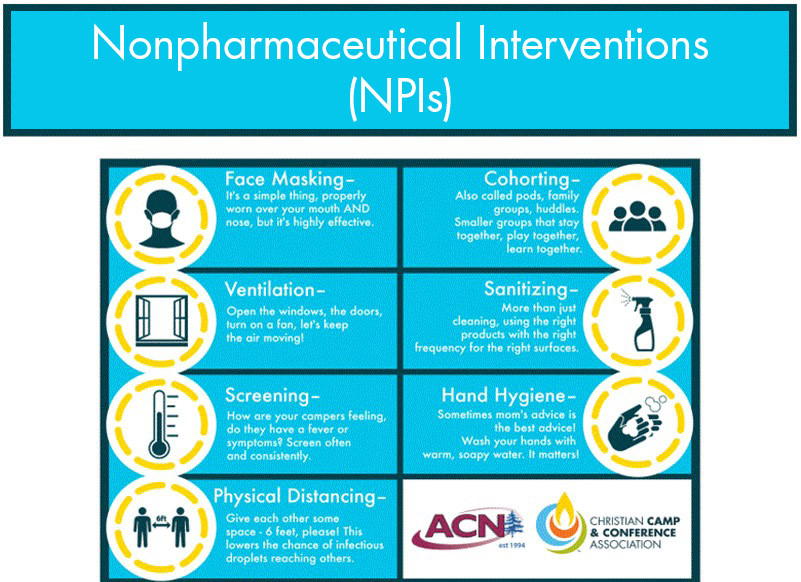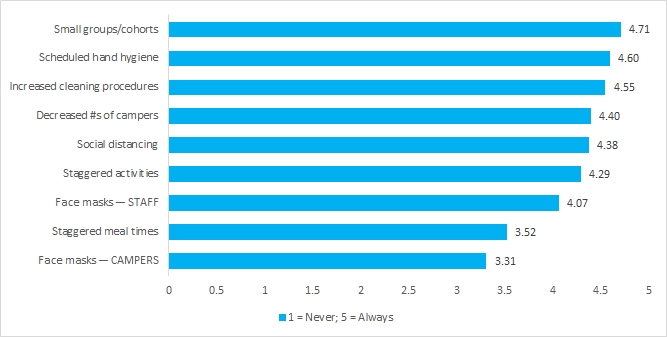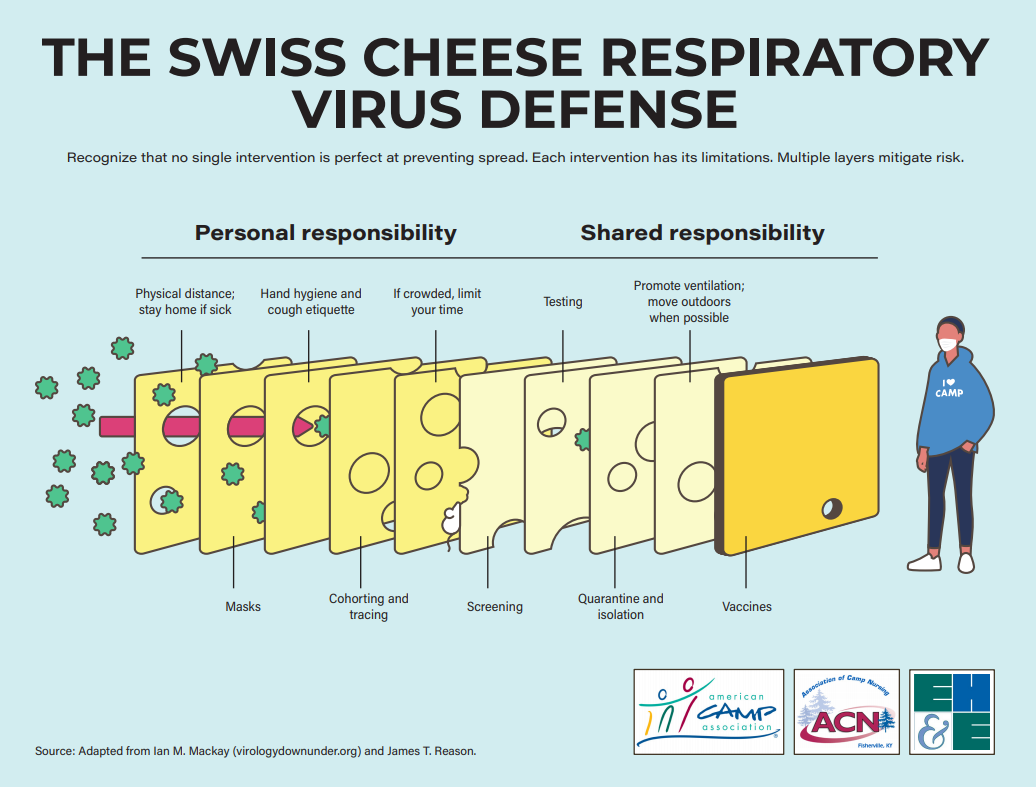Summer camp is an opportunity to make a lifelong positive impact on both campers and staff. During the summer of 2020, the camp community had to overcome many challenges to provide residential and/or day camp experiences. The onset of the COVID-19 pandemic resulted in unexpected state regulations, new safety requirements, necessary changes to activities, loss of financial income, operational barriers, and many other hurdles to conquer. Camps that operated in the summer of 2020 provided valuable feedback and evidence about their experience to inform how the camp community could improve programs and services in 2021 and beyond.
Following are a review of the nonpharmaceutical interventions (NPIs) performed by camps in 2020 and highlights of the newest NPIs for 2021: COVID-19 testing and vaccination. Benefits of a layered NPI approach for successful camp operation are stressed, as is the need for ongoing use of these NPI techniques to promote a healthy camp environment. Although there is no way to completely prevent COVID-19 or any other infectious illness, these NPIs prove to be an effective mechanism using a layered approach to risk mitigation. Based on evidence of the successful use of NPIs in camps, we encourage camps to continue using the NPIs for all camp sessions during the summer of 2021. While states may relax some of their requirements, your responsibility remains the same — to promote and facilitate the best possible prevention activities for the safety of your entire camp community.
NPIs of 2020
We have all been required to use NPIs in our daily lives. Good hand hygiene and face masks have become second nature for anywhere we gather in our communities. In 2020, we recommended seven NPIs for camps (see Figure 1).
Figure 1: Nonpharmaceutical interventions implemented in camps

The Association of Camp Nursing (ACN) has learned a great deal about each of the NPIs. Facemasks continue to be essential to minimize the spread of respiratory secretions. Current Centers for Disease Control and Prevention (CDC) recommendations for masks are two-layered, either cloth or disposable, that fit correctly on the face (CDC, 2021a). The use of “gators” as a face mask option is no longer recommended, as they are single layer and often made of thin fabric.
Hand hygiene is a second frequently used NPI. Hand hygiene can occur with soap and water or with hand sanitizer that is at least 60 percent alcohol. We have identified that hand sanitizer is more often used at camp due to accessibility. However, if soap and water is made more accessible, it is the preferred method of cleaning hands — especially if they are obviously dirty. It is important to teach all camp participants (i.e., youth, staff, and other guests) how to use hand sanitizer and make sure they are applying the sanitizer to not just the palms of their hands but providing good coverage to the fingers as well (CDC, 2020a).
Sanitizing was a key prevention technique outlined in 2020. The Environmental Health & Engineering Field Guide chapter outlines important parameters for sanitizing activities (EH&E, 2020). The Field Guide continues to encourage sanitizing practices that focus on frequency and high-touch areas. More frequent and effective cleaning helps to decrease fomite (i.e., materials that carry infection) transmission risk. Therefore, consider cleaning surfaces at least daily and in all high-touch areas at your camp. High-touch areas generally include tables (e.g., food, crafts, activity), doorknobs/handles, and bathroom facilities (e.g., showers, sinks, toilets).
Cohorting was the most frequently used NPI last summer. Cohorting is the process of organizing your camp population into small groups and navigating camp as a smaller group. The typical group (cohort) size during the summer of 2020 ranged from eight to 15 people. An important factor with cohorting is that cohorts do not mix during camp, which allows for good contact tracing and limits impact if someone becomes ill during the camp experience.
Table 1 – NPI Usage at Camp 2020*

* Garst, Dubin, Gaslin, Schultz, & Rodrigues (2021)
Another common NPI used in camps during the summer of 2020 was physical distancing, which promoted a concerted effort to try and keep individuals six feet apart. Given that relationship building is a foundational element of the camp experience, we realized that physical distancing would be one of the most challenging NPIs to address. Camps, however, rose to the occasion. For example, many used visual reminders so youth, staff, and guests would understand where camp administrators did not want people to sit, spray painted lines on grass to mark areas where cohorts could function, designated picnic and food service locations, and staggered activities and events (Association of Camp Nursing, 2020).
Two additional essential NPIs that made camp operation possible in the summer of 2020 were screening and ventilation. For residential camps, screening was implemented in three phases: pre-screening, initial screening, and ongoing screening. For day camps, the initial and ongoing screening periods were a combined effort, as staff and campers arrived each day requiring daily screening. The intent of screening was to help individuals raise their awareness of their personal health status with the hope of everyone arriving at camp in a healthy state. Awareness of health is essential for screening and early detection of illness, and asking staff and campers to self-assess daily for COVID-19 symptoms allowed camps to potentially prevent illness from entering the camp setting. The screening events included the common activities of temperature assessment and notation of COVID-19 symptoms. Pre-screening was completed by each individual prior to arriving at camp, while initial and ongoing screening occurred through the efforts of camp healthcare and program staff.
We also learned a great deal about ventilation in the summer of 2020. While ventilation was a topic of conversation in the spring before the summer camp season began, we now realize the importance of having ambient air movement as a mechanism for lowering the concentration of airborne respiratory droplets (EH&E, 2020). Ways that camps incorporated ventilation included creating outdoor picnics for food service, moving health services to outdoor tents, and limiting camper activities to those that could be offered outdoors. Camps that operated and were interviewed in 2020 and moved all activities outdoors reported no cases of COVID-19 (Association of Camp Nursing, 2020). Ventilation is encouraged as an ongoing NPI for camps to help decrease respiratory secretions by opening cabin windows, using ceiling fans, or any other mechanisms to create air movement.
NPIs are most effective when used concurrently. In 2020, the seven NPIs were promoted as a collaborative and coordinated effort. We continue to discuss the importance of “layering” NPI usage. That is, camps are encouraged to conduct screening along with requiring face masks, hand hygiene, cohorting, ventilation, sanitizing, and physical distancing, which creates a multifaceted approach to mitigating transmission risk of COVID-19 and other infectious diseases. As we approach the summer of 2021, two additional NPIs are available: testing and vaccination.
Additional NPIs 2021
Testing is the eighth NPI. Most camps did not have access to COVID-19 testing in the summer of 2020. This year, camps have an array of testing options for use with their staff and campers (Harvard, 2020). When considering testing, it is important to note why a camp is testing and when the camp should be testing. Testing is done for screening, diagnostic, and mitigation purposes. Screening testing is used in anticipation of camp participation by youth, staff, and other guests arriving to camp in a healthy state and or remaining in a healthy state through the experience. Therefore, screening testing needs to be done at a well-considered time to create confidence in the health of your camp population. Repeat screening testing is most often done at camps lasting longer than seven days, allowing for ongoing surveillance of the health status of individuals living together. For individuals who develop COVID-19 symptoms, diagnostic testing is a good option. Those in close contact with an ill individual can benefit from mitigation testing if appropriate.
Two types of testing are most appropriate for the camp setting: polymerase chain reaction (PCR) and antigen testing. The PCR remains the gold standard, but both of these tests are intended to detect active COVID-19 illness. For screening testing to be helpful, a camp will need to consider the time it takes to receive results from a chosen test. In some cases, this may mean a camp needs to test three to five days prior to start of camp. Testing will be most effective through proactive planning — choosing the timing and type of testing — that meets the needs of your camp population.
Vaccination is the ninth NPI. As vaccinations roll out across the US, we are hopeful that the vast majority of attendees will be vaccinated for summer camp. The COVID-19 vaccine helps each of us develop antibodies (immunity) to the illness and ultimately prevents transmission to others (CDC, 2021b). Research has demonstrated that the vaccines are effective and continue to undergo some of the most rigorous scrutiny by the FDA as the vaccine is rolled out to millions of individuals (CDC, 2021c). This news is very encouraging!
Several myths about the COVID-19 vaccine are still circulating, and we encourage you to investigate the evidence that supports the safety profile of these medications (CDC, 2018). Here are the basic facts about the COVID-19 vaccines.
- Vaccines are safe.
- You will not test positive on a PCR or antigen test following vaccination. You could test positive on an antibody test because the vaccine is working to create immunity against the disease.
- If you have had COVID-19, you should still get vaccinated.
- You will typically need two weeks after the last dose to build full-strength immunity against the virus.
Layering of NPIs
Now that we have nine NPIs, we want to create plans for summer 2021 that outline how individual camps will use these tools in conjunction with one another. We have discussed the layering effect of NPI usage over the past year (see Figure 2). Establishing a layering effect means that by adding each NPI together we can marginalize the risk of sharing the COVID-19 virus and other infectious diseases with others.
Figure 2: Layering NPI usage with the swiss cheese respiratory virus defense approach

For example, when we “layer” camper and staff face mask usage with good hand hygiene and then clean all the high-touch areas at camp, we are making great strides to eliminate viral transmission. When we further create air movement (ventilation) in our program areas and services by moving activities outside or using well-ventilated facilities, promote physical distancing, and have our camper groups navigate activities in their small family units (i.e., cohorts), we are really pushing COVID-19 away. Adding COVID-19 testing to our screening processes and having vaccinated staff available to serve and support campers will promote an overall healthy camp environment.
Now is the time to develop or revisit your strategic approach for mitigating COVID-19 in the summer of 2021. Consider your camp and how you might use as many NPIs as possible to thwart COVID-19. Make written plans that outline each of these tools and how you will integrate them into your camp operations. We wish each of you the best as you launch into summer camp 2021. The American Camp Association and ACN are here to promote education, resources, and support as you navigate this new world of camping in COVID-19 times. Let us know how we can assist you.
Tracey Gaslin, PhD, CPNP, FNP-BC, CRNI, RN-BC, is the executive director of the Association of Camp Nursing.
Barry Garst, PhD, is an associate professor of youth development leadership at Clemson University and to date has served two terms as chair of the Association of Camp Nursing’s Research Committee.
References
- Association of Camp Nursing (2020). COVID and communicable disease guide. Bemidji, MN: ACN.
- Centers for Disease Control and Prevention (2018). Finding credible vaccine information. CDC. Retrieved from cdc.gov/vaccines/vac-gen/evalwebs.html
- Centers for Disease Control and Prevention (2021a). Use masks to slow the spread of COVID. CDC. Retrieved from cdc.gov/coronavirus/2019-ncov/prevent-getting-sick/diy-cloth-face-coverings.html
- Centers for Disease Control (2021b). Understanding how COVID-19 vaccine work. CDC. Retrieved from cdc.gov/coronavirus/2019-ncov/vaccines/different-vaccines/how-they-work.html
- Centers for Disease Control (2021c).Ensuring COVID-19 vaccine safety in the US. CDC. Retrieved from cdc.gov/coronavirus/2019-ncov/vaccines/safety.html
- Centers for Disease Control and Prevention (2020a). How to select and use hand sanitizer (2020). CDC. Retrieved from cdc.gov/coronavirus/2019-ncov/prevent-getting-sick/hand-sanitizer.html
- Environmental Health & Engineering, Inc. (2020). Field guide for camps on implementation of CDC guidance. Retrieved from campnurse.org/education-and-resources/covid-19-considerations-for-camp/cdc-recommendations-for-camps-covid-19/
- Garst, B., Dubin, A., Gaslin, T., Schultz, B., & Rodrigues, A. (2021). Camp health care practices following the onset of the COVID-19 pandemic in the summer of 2020. 2021 American Camp Association Research Forum Abstracts. Retrieved from ACAcamps.org/resource-library/research/aca-research-forum
- Harvard University (2020). COVID-19 diagnostics in context. Retrieved from csb.mgh.harvard.edu/covid
Photo courtesy of Elbow Lane Day Camp, Warrington, PA.


